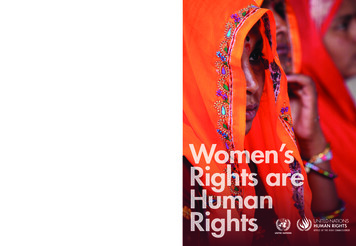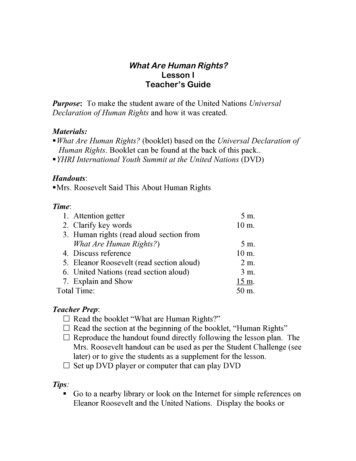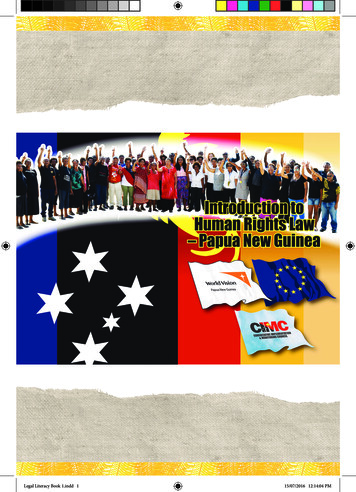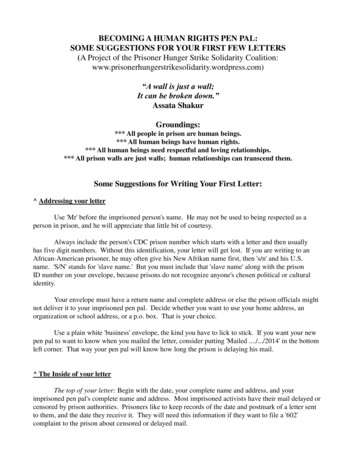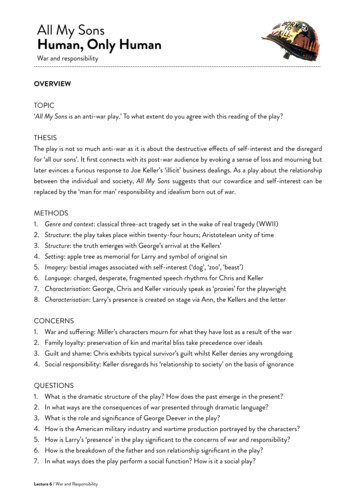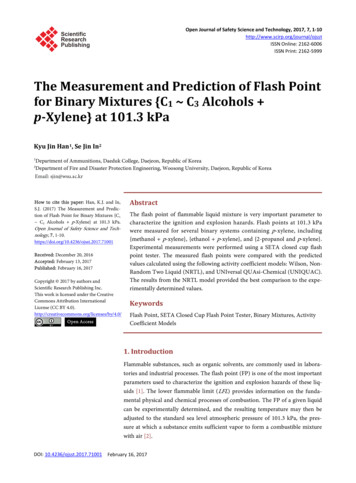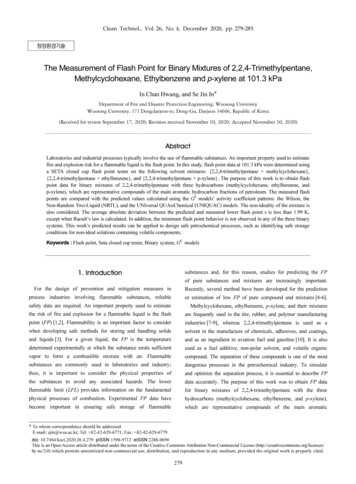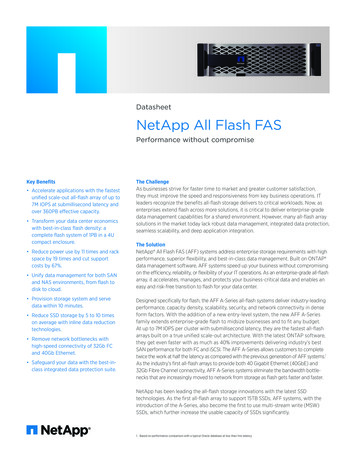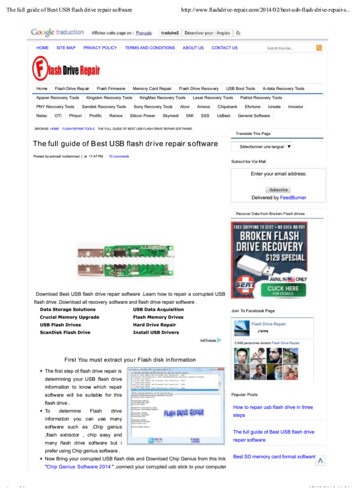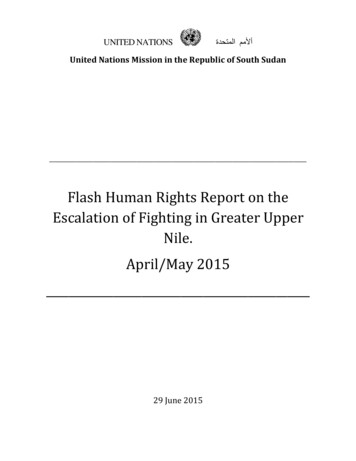
Transcription
UNITED NATIONS أألمم المتحدة United Nations Mission in the Republic of South SudanFlash Human Rights Report on theEscalation of Fighting in Greater UpperNile.April/May 201529 June 2015
1
I.Introduction1.Eighteen months after the start of conflict in December 2013, during which the scale and intensityof fighting has vacillated, fighting flared again in April 2015 and has been accompanied by allegations ofserious human rights violations and abuses. Within days after the latest fighting started, the UnitedNations Mission in South Sudan (UNMISS) Human Rights Division (HRD) started receiving reports fromcivilians fleeing the fighting from rural areas in Unity and later from Upper Nile and northern Jongleiabout alleged killings, rapes and abductions, along with the looting and destruction of civilian objectsand humanitarian assets.2.In accordance with its mandate to monitor, investigate and report on such allegations, HRDstarted interviewing civilians arriving at the protection of civilians (PoC) sites in Rubkona/Bentiu andgathering information from various partners operating in the areas. Parallel contacts were established withthe Sudan People’s Liberation Army (SPLA) and government officials, in addition to the Sudan People’sLiberation Movement/Army in Opposition (SPLA/M-IO), to gain access to the sites of alleged humanright violations and seek further information about allegations. HRD has been able to gather informationfrom various sources that confirm the upsurge in fighting in several parts of Unity, as well as in UpperNile, painting a grim picture in the aftermath of the fighting of its impact on the civilian population inthese areas.3.The upsurge in fighting and associated allegations of atrocities in Greater Upper Nile has drawnwidespread condemnation from international actors, including various senior United Nations officials, theAfrican Union, diplomatic missions and human rights organizations. HRD hopes that this report willcontribute to the efforts to bring an end to the violence, to hold perpetrators to account for the humanrights and humanitarian law violations that they have committed against civilians, especially women andchildren, and end the pervasive and persistent impunity.4.Information included in this report was gathered in accordance with the human rights monitoringand investigations methodology developed by the Office of the United Nations High Commissioner forHuman Rights (OHCHR). Incidents have been reported only if informed consent was obtained from thesource, and only if no protection risk was posed by its disclosure. This report documents some of theallegations of human rights violations received in April, May and early June 2015, but it should not beconsidered conclusive. This report merely aims to shed light on what HRD has been able to gather so farto complement information that has been reported by other actors and to offer an initial glimpse into newand disturbing levels of violence.5.HRD is pursuing efforts to interview victims, survivors and witnesses and investigate sites of thealleged violations as access permits, and as fighting continues. Following the recent attacks, UNMISS hascontacted SPLA to gain access to reach the scenes of the extensive violence – as much of the violence hasoccurred in rural locations without any UNMISS presence – but access was regularly denied. Indeed,during the period when most of the attacks took place, the SPLA had imposed restrictions of movementon UNMISS and humanitarian actors, thereby preventing possible human rights investigations andhumanitarian action in affected locations. This has caused delays in human rights investigations and theloss of crucial information.2
6.Following the attacks that began in April, HRD had by the time of writing been able to interview115 victims and witnesses, consisting predominately of females, from several villages in Rubkona, Guit,Koch, Leer and Mayom counties in Unity. From 26 to 29 April, UNMISS was not allowed to moveanywhere in the state, while movement was allowed sparingly between 1 and 25 May, and only thenbetween Rubkona and Bentiu, but not to locations where most of the alleged human rights violationsreferred to in this report took place. The first mission to such a location took place on 26 May, whenUNMISS conducted a mission to Nhialdiu. A second mission was conducted to Koch on 27 May, and athird on 29 May to Ngop in Rubkona County. Preliminary findings from these locations and othermaterials including satellite images and photos are consistent or corroborate most of the testimoniescollected from victims and witnesses.7.UNMISS is currently planning investigation missions to additional locations of alleged humanrights violations and therefore is encouraged by the recent announcement by the SPLA spokesperson thatit would facilitate access to the areas affected by the conflict. UNMISS is awaiting the opportunity toinvestigate and verify the allegations. Every day without access diminishes the chances of encounteringcritical information and increases the likelihood of continued impunity.II.The Upsurge in Fighting8.After an initial phase that included fighting in the capital, Juba, in December 2013, the conflict inSouth Sudan has since then been largely concentrated in the northeast of the country in the Greater UpperNile region, especially affecting the states of Unity and Upper Nile, as well as the northern part ofJonglei. The intensity and scale of the fighting has vacillated since December 2013, with spikes in Apriland October 2014 for example, along with periods of lull. This has meant almost persistent instability forthe civilian population in these areas and serious deprivations of their basic human rights.9.Since the last week of April 2015, an intense surge of fighting in Unity has been followed by thedefection of the formerly SPLA forces under the command of Johnson Olonyi in Upper Nile, leading toviolent battles for Malakal and Melut. In Jonglei, meanwhile, recent reports indicate that such northwestern areas as Fangak, Canal, Ayod and Duk have witnessed clashes.10.From witness accounts and UNMISS observations of the fighting in Unity starting late April, itappears that government forces attacked villages from three fronts in different directions: from Mayominto Mayom and Rubkona counties (first front); from Bentiu into Guit, Koch and Leer counties (secondfront); and from Lakes State into Mayendit and Panyjar counties (third front). [See map showing theattacks and civilian displacements.]3
4
Government forces from Mayom attacked villages south-east of Mayom county. Between 25 and 26April, the forces attacked Buoth, and then proceeded to Wicok. The forces then advanced from Wicok,joining the second front which advanced south-west from Bentiu and Rubkona on 29 April, to attack andcapture Nhialdiu, which had been the headquarters of the opposition for almost a year. Dozens of villageswere attacked along the way.11.Secondly, government forces attacked Nhialdiu and then moved east and south-east of Nhialdiu,and southerly from Bentiu to attack villages in Guit and Koch counties – capturing Guit and Koch on 30April and 8 May respectively. An UNMISS mission to Koch on 27 May revealed that the town was notthen in control of either side.12.Finally, government forces and armed militia from neighbouring Lakes attacked Mayendit, Leerand Panyjar counties between 15 and 19 May.13.Attacks on these locations uprooted thousands of civilians, who fled into the wilderness with littlechance to reach the UNMISS PoC site in Bentiu. This was in part due to existing SPLA defence ringsaround Bentiu and Rubkona. There is also evidence of the establishment of a new ring and additionalcheckpoints by the SPLA in the vicinity of the UNMISS PoC site, which, though set up to preventopposition movements, appears to have deterred or pushed civilians further away from any form ofprotection.14.Furthermore, witness testimonies indicate that the opposition forces were overrun by thegovernment forces and armed militias. For several months prior, the opposition had managed to holdcontrol of all southern counties, repulsing government forces each time they attempted to attack. This hadapparently created a certain level of confidence among civilians population living in the oppositioncontrolled areas, so that when the government forces launched attacks in April, most civilians wereprobably confident that the opposition would defend their territories. This did not happen, however, andmost civilians, mainly women and children, were caught unprepared in their homesteads.15.The nature and level of the new alleged human rights violation point to the further ethnicizationof the conflict represented by the introduction of associated armed groups comprised of militias drawnfrom specific communities. Lacking military training, militias from the various ethnic sub-groups of theregion have been armed to serve largely as auxiliaries to more conventional forces. Such non-traditionalarmed groups tend toward indiscipline and lack of customary respect for the authority of elders.1 The newtactics also appear to invite retaliatory strikes, as exemplified by an alleged SPLM/A-IO ambush of agovernment vehicle transporting civilians at Guit Junction in Unity on 7 June that left several women andchildren dead and others wounded.16.Notable in the attacks in Rubkona, Guit and Koch counties was government forces’ reliance onsuch militias from particular ethnic sub-groups, exploiting but also deepening rifts between ethnic1The rise and development of militia groups since the split in the SPLM in 1991, especially those comprised ofyouths, are given fuller treatment in Edward Thomas, South Sudan: A Slow Liberation (London: Zed Books, 2015),pp. 194-206 and 223-239.5
sections. Following these attacks, for example, a major conflict erupted between ethnic sub-clans in anUNMISS PoC site in Juba on 11 May, resulting in deaths and injuries. If fighting continues, the risk offurther divisions and potential problems will likely increase in the PoC sites in Bentiu, Malakal and Juba.Given the large number of IDPs still seeking refuge at UNMISS PoC sites, this threat presents a realchallenge for protection of civilians within the site. UNMISS is currently working on mitigatingmeasures.17.Thousands of civilians have been displaced by the recent fighting – mainly fleeing to swampyareas where SPLA’s mobility is hampered by an absence of roads, including river banks and bushes. Inthese locations, civilians often depend on water lilies and fish for food, while drinking river water. Therehave been estimates that over 100,000 civilians in Unity have been uprooted from their homes since theattacks began in late April.2 The UNMISS PoC site in Bentiu has thus far registered and verified over28,000 additional arrivals between 29 April and 15 June 2015, chiefly women and children, whileadditional verification is ongoing. At the time of writing this report, civilians continue to arrive at the site,after government forces vacated some of the checkpoints and routes that displaced civilians are using toreach the site.18.In Nhialdiu, Guit, Koch, Mayendit, Panyinar and Leer counties, humanitarian organizations wereforced to close down and evacuate staff, while their facilities, including schools, health clinics andcompounds, have been looted and vandalized barely one year after their establishment, following repeatedbouts of destruction by opposing sides. Even though attacks may subside with the arrival of the rainyseason, thousands facing a dire humanitarian situation will have to wait once again before facilities can berebuilt to provide them with most needed basic services.19.The escalation of a humanitarian crisis can also be closely related to abuses of human rights andserious violations of international humanitarian law. In addition to alleged violations as a direct result ofthe fighting, alluded to in this report, other possible violations tied to the humanitarian situation includedenial of humanitarian relief; destruction of property; violations of physical and mental integrity; andunlawful displacement of civilians.III.Allegations of Human Rights Abuses and Violations20.A failure both by the government and anti-government forces to protect civilians from violencehas marked the crisis since its beginning. This recent upsurge, however, has not only been marked byallegations of rampant killing, rape, abduction, looting, arson and displacement, but by a new brutalityand intensity, including such horrific acts as the burning alive of people inside their homes. (See image 1)The scope and level of cruelty that has characterized the reports suggests a depth of antipathy that exceedspolitical differences.2Amnesty International, South Sudan: Escalation of violence points to failed regional and international action, 21May 2015: sudan/. According to the International Organizationof Migration’s Crisis Response Displacement Tracking Matrix for South Sudan from May 2015, over 170,000individuals have been identified as displaced in Unity state alone, presumably since the beginning of the conflict inDecember 2013.6
Image 1: Burnt residential tukuls—Nhialdiu.21.Among the most serious allegations that have been received are those concerning the abductionand sexual abuse of women and girls by government forces and affiliated armed groups. Conflict-relatedsexual violence has marred the conflict since its beginning, but reports of rape have increased during thecurrent wave of fighting, particularly in Unity and Upper Nile. Children have also repeatedly beenobserved in uniform or carrying weapons, or both, in the company of both the SPLA and SPLM/A-IO andtheir associated armed groups. UNICEF on 18 May indicated that dozens of children in Unity had beenkilled, raped and abducted in recent weeks.22.According to testimonies from Unity, at least 172 women and girls have been abducted, while atleast an additional 79 were subjected to sexual violence including gang-rape. For example, a survivorfrom Koch County narrated to HRD how she was dragged out of her tukul and gang-raped alongside herneighbour by government soldiers in front of her three-year old child. The soldiers then taunted them thatthey would appreciate what men from Mayom County were made of. In another instance, a witness fromRubkona County narrated that she saw government forces gang-raping a lactating mother after tossing herbaby aside. While in another case, two witnesses from Nhialdiu narrated how a 17-year-old girl was gangraped by armed militia who shot her dead. In at least nine separate incidents, women and girls were burntin tukuls after being gang-raped, particularly in Boaw Village of Koch County. In at least five villages in7
Rubkona, Guit and Koch counties, women and girls were shot and killed after they were subjected togang-rape.23.According only to those interviewed, at least 67 civilians were killed in recent attacks in Unity.Approximately 40 civilians are reported still to be missing – mainly boys who may have been forciblyrecruited. There appears to be a consistent pattern in all the villages where attacks took place; namely ofgovernment forces burning tukuls after looting, including theft of animals. Humanitarian and civilianobjects – including schools, health facilities and properties of humanitarian organizations – were alsotargeted, looted and vandalized. (See image 2)Image 2: Vandalized Koch Health Facility.24.HRD has received at least nine allegations of torture or cruel treatment, referring to victims beingsubjected to beating so that they would reveal the whereabouts of opposition forces. In one disturbingincident, government forces placed a burning-red coal in the palms of a woman and squeezed her palmsinto a fist, in an apparent attempt to force a confession about whereabouts of the opposition forces and thelocation of cattle.25.These figures are certainly an under-representation of the actual magnitude of violations, as theycapture only those victims whose names were provided to HRD. There are additional reports of heinous8
violations against civilians, where names of victims or specifics of the incidents were not provided toHRD and are therefore not included in this account.26.Due to the recent surge in fighting, as indicated above, an additional 28,000 IDPs have soughtrefuge in UNMISS PoC sites in Unity, out of an estimated 100,000 displaced in that state.3 It is difficult toascertain where the majority remainder of those displaced in Greater Upper Nile have gone, but multiplereports indicate that most have waded into the many swamps in these areas where they may betemporarily out of the reach of the fighting forces. Some have reportedly tried to reach the UN PoC sitesbut may have been prevented from doing so. The presence of armed elements around the PoC sites in thethree state capitals in Bentiu, Malakal and Bor has also posed threats to those already inside. The ongoingfighting outside has not only resulted in injury and death among the displaced seeking safety in the sites,but has also recently sparked a dynamic of inter-ethnic or even inter-communal violence among rivalgroups inside the sites.27.Following the attacks, many groups of civilians attempted to make their way to reach theUNMISS PoC site in Bentiu. In Rubkona County, SPLA forces enhanced existing checkpoints orestablished new ones, thus preventing civilians from reaching UNMISS PoC base for humanitarianassistance. UNMISS received reports that many checkpoints were set up in the bushes and around or inthe vicinity of the PoC site, preventing vulnerable civilians from approaching the base. Indeed, many ofthose that came across these checkpoints were attacked, arrested, subjected to sexual violence, torture orkilled.28.A long history of conflict in the region has encouraged those living in its towns and villages toresort to remote refuges during times of danger or uncertainty, but their traditional coping mechanismsmay not suffice this time. As the rebellion spread across Unity, Jonglei and Upper Nile in December2013, the region was already the most food-insecure part of the country.4 Conditions since then havehardly been conducive to food production and adequate standards of living. The looming humanitariancrisis may prove to be at least as devastating to the civilian population as the direct impact of the violencehas been so far.IV.Perpetrators and Command29.Witness testimonies indicate that attacks on villages in Rubkona County were carried out bygovernment forces with the support of armed militias or armed youth from Mayom. The SPLA forceswere reportedly led by a Major General from the integrated South Sudan Liberation Army (SSLA) whoadvanced to Wicok and Nhialdiu from Wangkai in Mayom. Together with a senior county official forMayom, they commanded government forces and armed youth who allegedly played a major role inlooting and burning of homes and abduction of women. Such information has been provided andcorroborated by witnesses. One witness indicated that a local chief in one of the villages in Rubkona3Throughout the country, UNMISS hosts more than 135,000 displaced persons according to the most recent figures.See joint WFP/FAO press release of 7 March 2014: onflictreverses-progress-food-security.49
County confronted the Mayom county official (apparently because the chief knew him) and asked himwhy he was leading youth to harm civilians and steal their properties.30.Attacks in Guit and Koch counties were carried out by government forces and armed youths ledby two SPLA brigadier generals from the integrated SSLA and a senior county official for Koch County,according to witness testimonies. Such information was provided and corroborated by several witnesses.31.Lastly, attacks in Mayendit, Leer and Panyjar counties were reportedly carried out by governmentforces and armed youths from neighbouring Lakes State. So far UNMISS has been able to interview onlyone witness in relation to this. However, opposition officials have informed UNMISS that a senior countyofficial from Rumbek East County was among the commanders.32.In each of the attacks, the government forces were identified by their uniforms, insignia, tribalmarks, language and known acquaintances. Armed militia or youth who also took part in the attackscarried AK-47s, or simple or crude weapons such as spears, machetes and sticks.V.Engagement with State and Non-State Authorities33.On 15 May, UNMISS sent a letter to the SPLA and civilian authorities requesting the SPLA toallow unhindered movement of civilians fleeing conflict and ensure their safe passage to UNMISS PoCsite, urging them to protect and respect the human rights of all. In subsequent meetings with state officialsUNMISS called on them and the SPLA to guarantee UNMISS personnel’s freedom of movement tolocations where human rights violations had occurred and to allow freedom of movement for all civilians.34.On several occasions, UNMISS contacted the opposition in Unity state to advise them thatcivilians should not be prevented from seeking protection at the UNMISS PoC site or any other locationswhere they may wish to seek protection and assistance, and that their movement should he unhindered. Todate there have been no reports about the opposition restricting or denying movement of civilians,humanitarian organizations or UNMISS.35.At the national level, following statements issued by the UN on the attacks by the governmentforces, the SPLA stated that it would support investigations into any wrong-doing by the army, whiledenying that its forces were involved in human rights violations. Army spokesman Colonel Philip Aguerhas been quoted as stating: “there are organizations that are tarnishing the image of the SPLA as an army.In our rules of engagement, I really doubt the credibility of those people who say they witnessed rapingand killing. However, we continue to welcome an investigation into all the allegations.”536.On 26 May, the National Minister for Defence issued a four-point Ministerial Order requiring theSPLA and authorities to respect and protect the rights of civilians, to allow unhindered access tohumanitarian organizations and the United Nations, to provide unconditional safety access to allhumanitarian flights, and to ensure that the SPLA elements adhere to its rules and regulations. The5Voice of America, Sudanese Army Claims Capture of Rebel Stronghold, May 21, 2015.10
Minister further ordered that directives be issued to all units to that effect. [See annex – MinisterialOrder.]37.Despite such assurances, experience has shown that the culture of impunity remains strong inSouth Sudan. Reports from past national inquiries into allegations of human right violations and abuseshave not been released to public scrutiny. This practice has made it impossible to assess the credibilityand impartiality of such investigations, including their conformity with applicable international standards.It has equally prevented any attempt to pursue accountability.VI.Concluding Observations38.An escalation of the conflict in Greater Upper Nile has led to a serious deterioration of the humanrights situation in northeastern South Sudan over the past two months. In Unity, UNMISS has alreadyconducted dozens of interviews with displaced civilians who were victims and witnesses of allegedatrocities by SPLA and associated forces since late April, as they pushed south from Mayom and Bentiutoward the opposition-held zone around Leer, destroying villages on the way.39.On 11 May, following initial interviews, UNMISS released a press statement on the ongoingviolence, highlighting concerns about continuing and consistent reports of the burning of towns andvillages, killings, abductions of males as young as 10 years of age, abduction and rape of girls and womenand the burning alive of people inside their homes. While approximately 28,000 IDPs have managed tofind refuge at the PoC site in Bentiu during the period covered in this report, UNMISS fears for the fatesof the many thousands of IDPs stranded in the swamps of southern Unity.40.In a demonstration of international consensus to condemn the alleged atrocities, press releasesrelated to the fighting in Unity and Upper Nile were issued by a number of international sources,including press releases by the United Nations Security Council on 17 May, followed by the SecretaryGeneral on 20 May. On 18 May UNICEF issued a statement reporting that dozens of children in Unityhad been killed, raped and abducted in recent weeks. The African Union joined the refrain on 24 May, notonly condemning the human rights violations, but also demanding sanctions and an arms embargo.Amnesty International released a report on 21 May following a research visit to Bentiu, detailing humanrights violations and also calling for sanctions.41.The SPLA spokesperson has repeatedly dismissed claims of SPLA committing human rightsviolations and stated that he welcomed investigations into the allegations. UNMISS calls on the SPLA tohonour this commitment and grant HRD unfettered access to the sites of reported violations. Revealingthe truth of what happened offers the best hope of holding perpetrators to account and ultimately endingthe cycle of impunity that allows such terrible violence against civilians to continue. All parties mustcease acts amounting to human rights violations and violations of international humanitarian law, whilethe Government of South Sudan must carry out comprehensive, credible and transparent investigations toensure that perpetrators are brought to justice.11
Annex.12
13
of fighting has vacillated, fighting flared again in April 2015 and has been accompanied by allegations of . apparently created a certain level of confidence among civilians population living in the opposition . children dead and others wounded. 16. Notable in the attacks in Rubkona,
